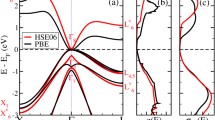Abstract
Currently, the materials with the highest thermoelectric figure of merit (ZT) are one-band materials. The presence of both electrons and holes lowers ZT, so two-band materials such as semimetals are not useful thermoelectric materials. However, by preparing these materials in the form of two-dimensional quantum-well superlattices, it is possible to separate the two bands and transform the material to an effectively one-carrier system. We have investigated theoretically the effect of such an approach and our results indicate that a significant increase in ZT may be achieved. We have also evaluated the possibility of using intercalation as a means to achieve an increase in ZT. Our results allow the possibility of using new types of materials as thermoelectric refrigeration elements.
Similar content being viewed by others
References
H. J. Goldsmid, Thermoelectric Refrigeration (Plenum, New York, 1964).
H. J. Goldsmid, Electronic Refrigeration (Pion, London, 1986), p. 2.
L. D. Hicks and M. S. Dresselhaus, Phys. Rev. B 47, 12727 (1993).
J. N. Schulman and T. C. McGill, in Synthetic Modulated Structures, edited by L. L. Chang and B. C. Giessen (Academic, Orlando, 1985), pp. 96–98.
J. M. Berroir, Y. Guldner, J. P. Vieren, M. Voos, and J. P. Faurie, Phys. Rev. B 34, 891 (1986).
C. F. Gallo, B. S. Chandrasekhar, and P. H. Sutter, J. Appl. Phys. 34, 144 (1963).
N. W. Ashcroft and N. D. Mermin, Solid State Physics (Saunders College, Philadelphia, 1976), Chap. 13.
D. Schiferl and C. S. Barrett, J. Appl. Crystallogr. 2, 30 (1969).
M. S. Dresselhaus, in Proc. Conf. Phys. Semimetals and Narrow-Gap Semiconductors, Dallas 1970, edited by D. L. Carter and R. T. Bate (Pergamon, Oxford, 1971), pp. 16–17.
R. T. Isaacson and G. A. Williams, Phys. Rev. 185, 682 (1969).
G. A. Saunders and Z. Sümengen, Proc. Roy. Soc. London A329, 453 (1972).
D. L. Partin, J. Heremans, D. T. Morelli, C. M. Thrush, C. H. Oik, and T. A. Perry, Phys. Rev. B 38, 3818 (1988).
S. C. Shin, J. E. Hilliard, and J. B. Ketterson, Thin Solid Films 111, 323 (1984).
N. B. Brandt, S. M. Chudinov, and V. G. Karavaev, Sov. Phys. JETP 34, 368 (1972).
M. S. Dresselhaus and G. Dresselhaus, Adv. Phys. 30, 139 (1981).
V. A. Kulbachinskii, Z. D. Kovalyuk, and M. N. Pyrlya, Phys. Stat. Sol. (b) 169, 157 (1992).
Author information
Authors and Affiliations
Rights and permissions
About this article
Cite this article
Hicks, L.D., Dresselhaus, M.S. Use of Quantum-Well Superlattices to Obtain a High Figure of Merit from Nonconventional Thermoelectric Materials. MRS Online Proceedings Library 326, 413–418 (1993). https://doi.org/10.1557/PROC-326-413
Published:
Issue Date:
DOI: https://doi.org/10.1557/PROC-326-413




